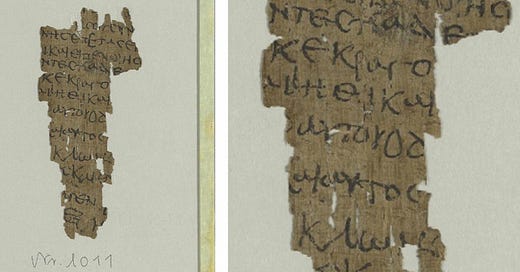What's with the new Infancy Thomas fragment?
And why does Jesus call someone an insolent, godless dunderhead?
Headlines like this test my sanctification.
“Experts discover earliest record of Jesus' childhood after deciphering 2,000-year-old Egyptian manuscript.”
Help me, Holy Ghost. Help my eyeballs not to roll completely out of my skull and onto the floor.
A few of things: First, this “record” is thirteen lines of text on two by four inches of papyrus. It’s a textual fragment.
Second, the fragment isn’t 2000 years old. It’s probably from the fourth or fifth century. So it’s maybe 1700 years old at the earliest. In terms of ancient manuscripts, 300 years is an eternity. If the manuscript were actually 2,000 years old, it would be from the generation of Jesus and his first followers. As it stands, at the earliest it’s from the same century as the Nicene Creed. It’s possibly later than Augustine of Hippo.
Third, this isn’t a new document. It’s a previously undiscovered fragment of a document of which we already had copies, the Infancy Gospel of Thomas (IGT). Most scholars date IGT to the late second century. It’s clearly dependent on Luke in some parts. The earliest reference to it is from Irenaeus, who was writing around 180. The fragment in question tells the story sometimes called the “vivification of sparrows”:
When this boy Jesus was five years old he was playing at the ford of a brook, and he gathered together into pools the water that flowed by, and made it at once clean, and commanded it by his word alone. He made soft clay and fashioned from it twelve sparrows. And it was the sabbath when he did this. And there were also many other children playing with him. Now when a certain Jew saw that Jesus was doing in his play on the sabbath, he at once went and told his father Joseph: “See, your child is at the brook, and he has taken clay and fashioned twelve birds and has profaned the sabbath.” And when Joseph came to the place and saw it, he cried out to him, saying, “Why do you do on the sabbath what ought not to be done?” But Jesus clapped his hands and cried to the sparrows, “Off with you!” And the sparrows took flight and went away chirping. The Jews were amazed when they saw this, and went away and told their elders what they had seen Jesus do (2, Ron Cameron, ed., The Other Gospels: Non-Canonical Gospel Texts, WJKP, 1982, 124-5).
Interestingly, a reference to this story shows up in the Qur’an:
[The Day] when Allah will say, “O Jesus, Son of Mary, remember My favor upon you and upon your mother when I supported you with the Pure Spirit [i.e., the angel Gabriel] and you spoke to the people in the cradle and in maturity; and [remember] when I taught you writing and wisdom and the Torah and the Gospel; and when you designed from clay [what was] like the form of a bird with My permission…” (Surah Al-Ma'idah - 110).
It’s a story we’ve known about for a long time, then. This manuscript is just earlier than any other manuscript we have by at least a century, possibly more, and it’s in Greek, which may have been its original language. So that’s pretty cool for people who like to nerd out on such things.
Fourth, it’s a stretch to call this a “record” of Jesus’ childhood. It’s more accurate to call it a fragment of a record of a legend that arose about Jesus’ childhood in the post-apostolic period. The canonical gospels, which are the earliest records of his life we have, never relate any miracle story prior to his baptism. Could Jesus have performed miracles before his baptism? He was, of course, always the Son of God (i.e., he was not made to be the Son of God at some point during his life), but we have no early record of any miracles prior to the commencement of his ministry as an adult.
And then there’s the matter of the depiction of Jesus in IGT:
But the son of Annas the scribe was standing there with Joseph; and he took a branch of a willow and (with it) dispersed the water which Jesus had gathered together. When Jesus saw what he had done he was enraged and said to him: “You insolent, godless dunderhead, what harm did the pools and the water do to you? See, now you also shall wither like a tree and shall bear neither leaves of root nor fruit.” And immediately that lad withered up completely; and Jesus departed and went into Joseph’s house. But the parents of him that was withered took him away bewailing his youth, and brought him to Joseph and reproached him: “What a child you have, who does such things” (3).
Yikes! That kid needs a time out. At one point, Joseph says in exasperation to Mary, “Do not let him go outside the door, for all those who provoke him die” (14). And apart from all that, he calls people mean names! Reminds me of a song:
Mary did you know
That your little boy
Would kill the insolent, godless dunderheads?
Don’t try that one at church, kids. (Mrs. Watson, by the way, says that Jesus would never call anyone a dunderhead.)
Fifth, even if we did take the story of the vivification of the sparrows as a record of Jesus’ childhood, it still wouldn’t be the earliest record since we have anecdotes about Jesus’ childhood in Matthew and Luke.
So the discovery of this new manuscript is interesting to scholars of early Christianity, particularly those who focus on non-canonical texts and textual criticism. In terms of its significance for the Christian faith, let’s just say there was a reason IGT was never canonized.





